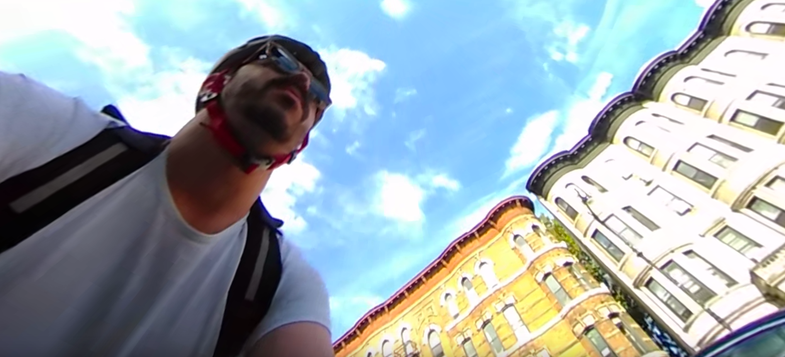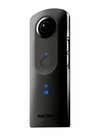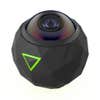The Ricoh Theta S and 360Fly 4K in a VR Action Camera Field Test
Road-testing the Ricoh Theta S and 360Fly 4k

We may earn revenue from the products available on this page and participate in affiliate programs. Learn more ›
If you haven’t gotten to try out a 360° action camera yet, you may find yourself boggled by the proliferation of forms and functions that the new cameras have. While no two are exactly alike, they share the ability to produce immersive, “spherical” videos, whose point of view can be changed later, allowing viewers to navigate around the video, using either their mouse cursor, smart device, or virtual reality headset.
To get a handle on these devices for myself, I recently road-tested two popular models, the Ricoh Theta S and the 360Fly 4K, on my morning bicycle commute. Using a third-party mount, I attached each camera to the same spot on my handlebars on two consecutive days with comparable lighting conditions. Afterwords, I unloaded the videos that each camera made using the manufacturer’s proprietary software.
The quality of the videos shown are not fully representative of the maximum resolution attainable by each device. When uploading the footage to YouTube or DailyMotion (two hosting services that support immersive video), videos are compressed for streaming and quality is reduced. As this format gains tractions, streaming services may improve their compression, but for now, resolution takes a back seat to the more experiential aspects of the medium online.

The Ricoh Theta S, has been out for just about a year and has already become a favorite among some 360° pros and enthusiasts. This tall, thin device is shaped rather like an overgrown flash drive that has two fish-eye lenses on either side of its lightly rubberized body. Its dual optics record FullHD footage at 30 fps for up to 25 minutes on its 8 GB internal memory. Designed for easy use, the Theta S has a total of four buttons which control its power, video/photo functionality, WiFi connectivity and electronic shutter.
The video files created by the device can be offloaded wirelessly (this can be a tedious and time-intensive procedure, depending on your connection) or via a provided USB cable. Using Ricoh’s downloadable software, also called Ricoh Theta, the two “hemispherical” videos from the wide-angle lenses are merged into a single, spherical video.
Ricoh Theta S Road Test by popphoto
Footage from the Ricoh Theta S appears sharper and smoother when viewed locally on a home computer, before being uploaded and compressed by video streaming services. That being said, those accustomed to the fairly high resolution video now provided by even smartphones, may be let down by the quality. Additionally, the camera takes a moment to adjust between differing exposures, sometimes blowing out highlights or under-exposing shaded areas when moving quickly between different lighting conditions. However, the camera scores point for ease of use, being simple to activate and record. Notably, the Ricoh Theta S is also a “true” 360°, meaning its two lenses capture almost 100% of the field of view around the camera. This translates to a more fully “immersive” video, meaning views can pan around and experience a full view around the camera as its recording. Many similar action cameras, like those produced by 360Fly, are also touted as “360°” but don’t capture a complete field of view.

About half as old as the Ricoh, 360Fly’s 4K action action camera, takes a different approach to capturing spherical video. With a single, 240° view-angle ultra-wide lens, the 360Fly resembles a miniature geodesic dome, encased in a black faceted shell. While not hewing to the 16:9 aspect ratio that defines most 4K resolution standards, the pixel density of the square 2800 x 2800 video qualifies the 360Fly 4K for equivalent quality, though it might not numerically compute at first glance. Its 30 fps high-resolution footage and omni-directional audio are stored on 64 GB of internal memory and a single button in the center of the device controls power, mode selection and shutter control.
Videos from the 360Fly 4K can be transmitted wirelessly to your Android or iOS device via Bluetooth, or downloaded to your desktop via an included proprietary USB dock. A free, downloadable application called 360Fly Director is simple yet versatile and allows you to import, organize, merge, trim, and export video to YouTube and the company’s own immersive video streaming platform. 360fly also offers a mobile platform that allows consumers to shoot, edit and share videos made with the device.
The videos from the 360Fly, as mentioned before, appear sharper before uploading them to the web where they’re compressed and degraded by many of the services that currently support 360° content. Even compressed, the footage from the 360Fly looks crisper and more colorful than that of the Theta S, thanks to its larger sensor. Additionally, it seems to adjust to rapid changes in lighting conditions a bit faster than the Ricoh. However, the videos produced by the 360Fly are not fully spherical, leaving a blank space at the bottom of the playback window that some users may not like. While its pared-down design is good looking, I also had some difficulty operating the camera as it relies on a single button for all of its functions, and I often found myself spending a minute or two just trying to get the device to record.